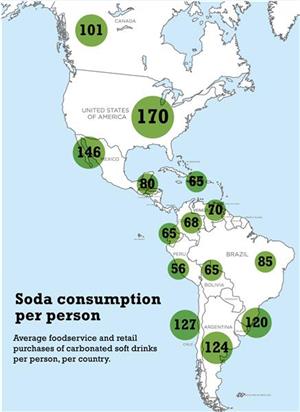Latin American country ranks high in worldwide soda consumption figures
There remains some debate about exactly how much soda or soft drinks Argentines consume, but one thing is clear — the number is exceptionally high.
In various global rankings over the past decade, Argentina has always held one of the highest positions on every list. The country doesn’t quite reach the heights of Mexico, which consumes staggering amounts of gaseosas, but nonetheless the level of consumption should be more than enough to worry health officials.
Statistics from 2011, complied by the data firm Euromonitor International, put the United States atop the rankings with a consumption rate of 170 litres per person a year. Mexico followed behind on 146 litres, with the South American trio of Chile (127 litres), Argentina (124 litres) and Uruguay (120 litres) behind in third, fourth and fifth places respectively.
But whereas global consumption of soft drinks has fallen over the past decade, the amount of soda being drunk by Argentines seems to be growing.
President Cristina Fernández de Kirchner raised eyebrows back in February earlier this year, when she announced that Argentina was the biggest consumer of soft drinks in the world and said that fact was a source of national pride. The president argued that the current rate of consumption indicated how much improved the economic situation is in the country today, compared to a decade ago.
“I want to say something to the Argentine people: this, our country, your country, is the country that consumes the most soft drinks in the whole world — 137 litres per capita,” Fernández de Kirchner said in a National Address.“In 2003 we had less money to buy Coca-Cola for our children.”
She credited the rising number to increased employment and to the implementation of the Universal Child Allowance (AUH) scheme.
Whereas global consumption of soft drinks has fallen over the past decade, the amount of soda being drunk by Argentines seems to be growing.
Factchecking
Fernández de Kirchner’s claim was later factchecked by Chequeado, an organization that tries to determine the truth in public discourse. Using updated statistics from Euromonitor, Chequeado confirmed that Argentina is now the world’s leading consumer of soft drinks, leapfrogging Chile, Mexico and the United States.
The organization pointed out however that Euromonitor’s statistics do not take into account the relationship between wealth, GDP and other development indicators.
While the president’s claims of greater spending power today may be true, this vast amount of consumption adds up to a potential health epidemic. For example, one 600ml bottle of a soft drink contains more sugar than a person’s total recommended daily allowance.
Argentina is also among the countries that consumes the most sugar, along with the US and Brazil, reported one recent study by Credit Suisse.
One possible explanation for the high consumption rate could be cultural.
The impulse to mix armargo-like drinks, or say Fernet, with soft drinks like Coca-Cola is a regular part of everyday life (especially at an asado) and represent — to me, at least — the spirit of improvization among Argentines.
Other drinks like Gancia and Campari are often mixed true with other sodas, such as Sprite or fizzy grapefruit soda. Then there’s the rumoured habit of mixing red wine with Coke, which seems almost blasphemous considering the standard of wine in Argentina.
Before I moved to Buenos Aires, I thought my fellow countrymen (English people) consumed a lot of soft drinks, but I’ve been surprised how much soft drinks are consumed by people of all ages here, not just the younger people in society.
My countrymen of course are famously more fond of alcohol, which brings with it even more severe health problems.
@URLgoeshere
Originally published in the Buenos Aires Herald, on Sunday, October 11, 2015,
as part of the On Sunday supplement which I edit.
Link: http://www.buenosairesherald.com/article/200578/argentina%E2%80%99s-thirst-for-gaseosas.


